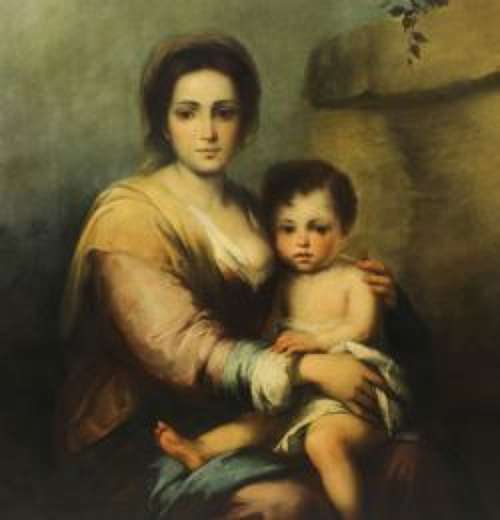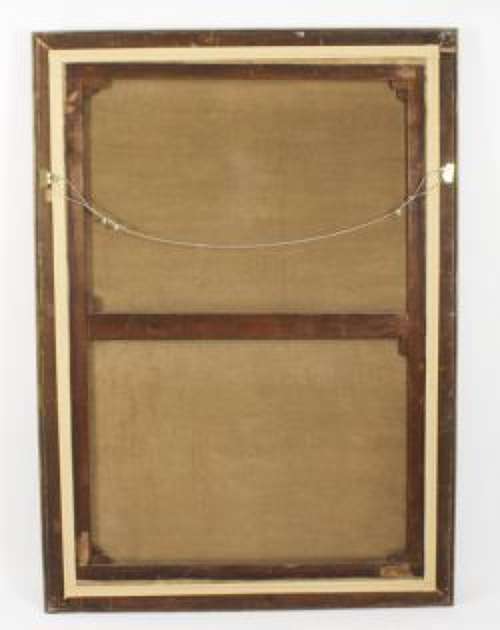Antique Painting Our Lady Of The Rosary After Bartolom Murillo 175x125c 19th C
Delivery Quote Request
Please fill in the form below to request a delivery quote from Regent Antiques.
Contact Regent Antiques
 London, United Kingdom
London, United Kingdom
Simply fill in the below form to get in touch with Regent Antiques regarding this item.
About this item
A large Spanish oil on canvas of Our Lady of The Rosary after Bartolom Esteban Murillo, early 19th century in date.
It features the Virgin Mary holding baby Jesus in her arms, she is dressed in a flowing traditional costume set against the background of an ancient building.
This superbly accomplished painting is executed in the style of Murillo's later works where he continued to evolve to the very end. In the last decade of his life, Murillo took Rubens's lesson even closer to heart, during this period his brushwork became looser and more visible than ever before, sometimes even to the point that the canvases appear unfinished.
Murillo also reduced his palette to the more sober hues of mauve, grey, brown, and carmine, making his late style more refined than in any previous period.
His style of painting the street children of his native Seville was unprecedented. He employed great naturalism, employing a sombre palette and strong chiaroscuro, contrasting lights and darks, and very little background detail. They are caught, like a photographic snapshot, playing or eating, but are very rarely aware of an onlooker.
This magnificent painting is housed in a striking gilded frame decorated with acanthus leaves.
It is beautifully executed and as such would make a lovely addition to your collection.
Condition:
In really excellent condition the painting and frame having been beautifully cleaned, please see photos for confirmation.
Dimensions in cm:
Height 175 x Width 125 x Depth 6.5
Dimensions in inches:
Height 5 foot, 9 inches x Width 4 feet, 1 inch x Depth 3 inches
Bartolom Esteban Murillo
Bartolom Esteban Murillo, (baptized January 1, 1618, Sevilla, Spaindied April 3, 1682, Sevilla), the most popular Baroque religious painter of 17th-century Spain, noted for his idealized, sometimes precious manner. Among his chief patrons were the religious orders, especially the Franciscans, and the confraternities in Sevilla (Seville) and Andalusia.
Among Murillos earliest works is the Virgin of the Rosary (c. 1642). In the vestigial style of his artistically conservative Sevillian master, Juan del Castillo, this early work combines 16th-century Italian Mannerism and Flemish realism. The 11 paintings that originally hung in the small cloister of San Francisco in Sevillae.g., the Ecstasy of St. Diego of Alcal (1646)are executed in the more contemporary naturalistic style of the Sevillian school, established by Diego Velzquez and continued by Francisco de Zurbarn. That series is characterized by realism and tenebrism (contrasting light and shade) and use of commonplace models, with an emphasis on genre or scenes of everyday life.
In the 1650s a striking transformation of style occurred, usually attributed to a visit to Madrid, where Murillo undoubtedly met Velzquez and studied the works of Titian, Peter Paul Rubens, and Anthony van Dyck in the royal collections. The softly modeled forms, rich colours, and broad brushwork of the 1652 Immaculate Conception reflect direct visual contact with the art of the 16th-century Venetians and the Flemish Baroque painters. The St. Leandro and St. Isidoro (1655) are even further removed from the simple naturalism of his earlier Franciscan saints. These seated figures, more than life size, are in the grand manner of Baroque portraiture, which had become fashionable at the Spanish court.
The Vision of St. Anthony (1656), one of Murillos most celebrated pictures, is an early example of his so-called vaporous style, which was derived from Venetian painting. In 1660 Murillo was one of the founders and first president of the Academy of Painting in Sevilla. During the two following decades he executed several important commissions, generally representing dramatized genre on a grand scale. From 1678 onward Murillo worked on another series of paint
Internal Ref:
A3489
Date of manufacture : 1800
Additional Information
1026111 (AB-182361)
W: 125cm (49.2")H: 175cm (68.9")D: 6.5cm (2.6")
![]() London, United Kingdom
London, United Kingdom
Regent Antiques was established in 1980. Born out of a natural love for art and beautiful objects, we have been a highly respected member of the antique fraternity ever since. Industry bodies of which we are a member include LAPADA and CINOA. Over the decades our business has gradually evolved...



























